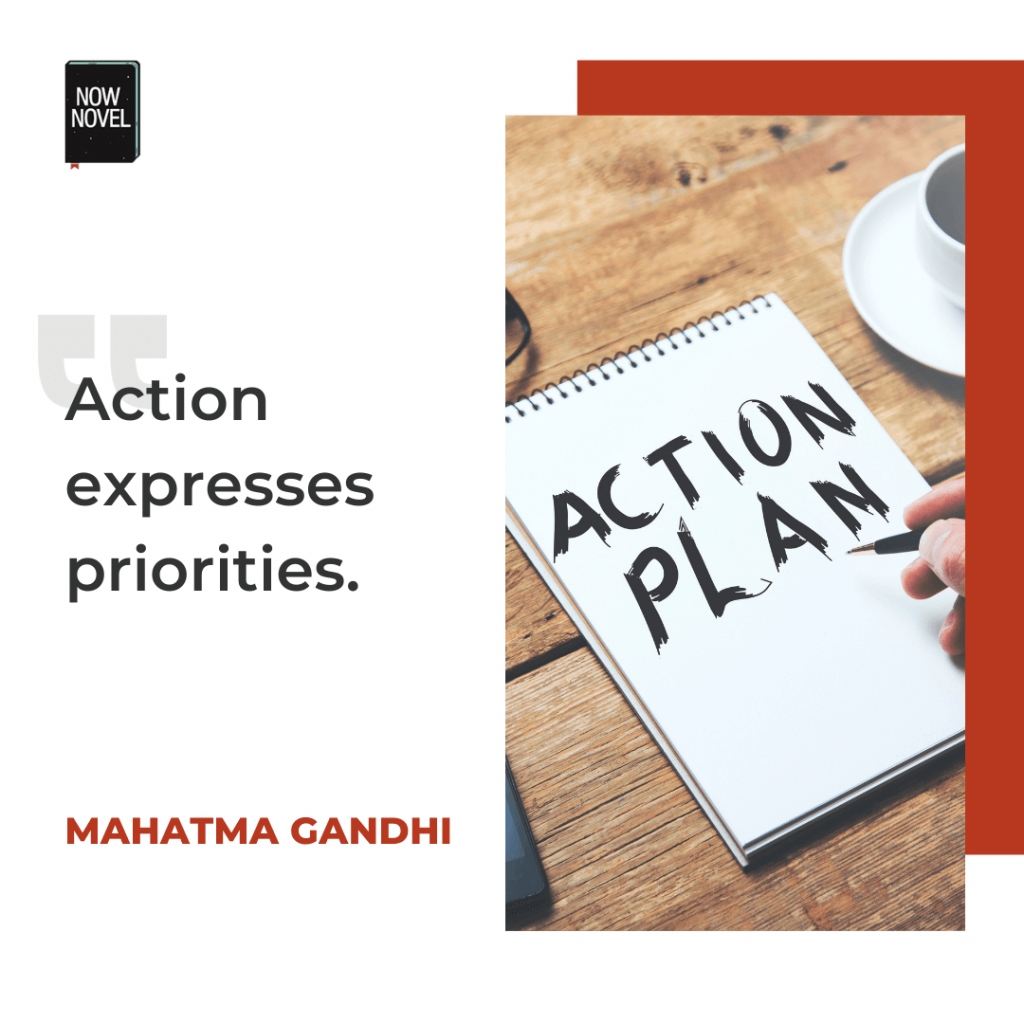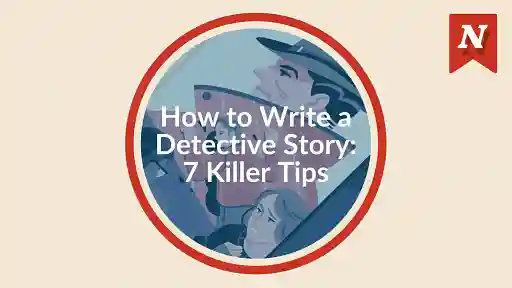'Action' and 'pacing' are two crucial elements in all stories, particularly in action/adventure and mystery/thriller novels. Knowing how to write action well keeps your tale engaging and fun. Here are 8 tips to help you pace your action story:
How to write action better:
- Understand strong action and pace
- Favour active voice
- Describe deeds, movements and gestures
- Focus on characters' goals
- Keep setting and description relevant to your action story
- Use shorter sentences to increase pace
- Set off chains of cause and effect
- Cut filter words
Let's examine each of these points closer:
1: Understand strong action and pace
You likely already have some idea of what action and pace are, but looking at official definitions is often a useful reminder of key aspects.
The official definition of 'action', for example, is 'the fact or process of doing something, typically to achieve an aim.' (OED). The second part of the sentence is key: Action in a story is aim- or goal-oriented.
We show Pete loading up a revolver in Scene One because we want the reader to anticipate a shooting in Scene Two (or Three, Four, or Five).
Actions are significant.
Action or thriller novels are all about significant actions building (or spiralling) to either foreseeable or surprising conclusions.
'Pace' is 'the speed or rate at which something happens or develops'.
'Happens or develops' here reminds us that pace in a story can refer to the pace of an individual scene as well as the rate at which plot events or characters - larger arcs - develop. Something happens in the moment, consequences develop over a duration.
Action vs pace example: Twin Peaks
Consider this example: David Lynch's reboot of his cult classic TV series Twin Peaks. The pace of story development is slow. The series was filmed as an 18-part 'movie', thus individual episodes do not necessarily build to a climax. Yet there is sustained pacing and tension within individual scenes. The director gradually reveals the links between these well-paced scenes as the wider story unfolds.
In the above example, there are two scales of pace. Individual scenes have their own pace, the rate at which events occur over a timeline.
Pace is also measurable over the arc of the entire story.
Think about the small-scale and larger-scale pacing in your own writing. How do specific actions affect your story's pace?
What weakens action and pace?
Action in writing weakens when:
- Characters spend more time in their heads thinking than doing
- There are long dialogue sections where (for example) a villian shares their many plans and misdeeds
- Sentences are too long and overwrought - stripped down sentences are faster to parse, so the reader moves faster
Pace in writing weakens when:
- The author spends too much time sharing irrelevant or unrevealing descriptive detail (detail that doesn't suggest the potential for action, such as Pete loading his gun and putting it in the trunk of his car)
- Scenes are not directed enough - remember that action implies aim
- Sentences are long and overly complex
Avoid scene elements that dry up action to keep your novel moving.
2: Favour active voice
Writing in active voice is crucial for keeping both action and pacing taut.
Compare these two sentences, for example:
'Pete loaded the revolver and placed it in his trunk, checking the road clear behind him.'
Now in passive voice:
The revolver was loaded and placed by Pete in his trunk, while the road was checked to see if it was clear.
See how the auxillary verbs ('was') and prepositions ('by') begin to creep in and add unnecessary bulk to the sentence?
Compare now to this action-heavy extract (in active voice) by Chuck Palahnuik, from Fight Club:
Four minutes.
I tongue the gun barrel into my cheek and say, you want to be a legend, Tyler, man, I'll make you a legend. Ive been here from the beginning.
I remember everything.
Three minutes.Chuck Palahnuik, Fight Club (1996), p. 6
The passage is fast-paced. Palahnuik includes the countdown of an explosives timer as sentence fragments, creating a sense of urgency.
To this the author adds Tyler playing games with the narrator, holding a gun in the narrator's mouth.
The verbs ('I tongue', 'I'll make', 'I've been', 'I remember') are all in active voice. Palahnuik breaks conventions of dialogue by not using speech marks but having the narrator's words flow together without punctuation or italics to identify whether they are thoughts or spoken words.
3. Describe deeds, movements and gestures
Getting stuck in your characters' minds weakens action. Instead, focus on your characters' deeds, movements and gestures.
To increase pace in a scene, you might:
- Add urgency to actions. Describe characters caught in a time-sensitive process (as in Palahnuik's insertion of the bomb countdown between his narrator's thoughts)
- Interrupt actions with other actions. For example: 'As he placed the revolver back in the hidden compartment, a strange shuffling noise came from the gap beneath his bedroom door'
- Use strong, active verbs. Instead of 'he ran', 'he sprinted'. Instead of 'she stood', 'she sprang to her feet'. As with all emphatic description, use discretion. If every character springs to their feet every other page, this will stand out as an authorial crutch or habit
Focus on characters' movements and gestures that are giveaways of their psychological states or intent. A jewel thief might slide on their belly to avoid alarm beams, for example, so that they can escape detection.
4. Focus on characters' goals
The action in your story reveals (and grows out of) characters' aims.
Compare, for example, two scenarios:
- A character decides to rob a bank and shares their thoughts about this decision.
- The same character cuts out slits in a stocking to make eye holes, or meets a shady character to buy illegal weapons (with the implied purpose of some or other criminal activity)
Which is the more intriguing introduction to the action that will follow?
Developing plot using characters' actions is effective because you can split the signifiance of a causal action from the consequence of its effect.
As we see causes piling up (Pete cleaning out and loading his revolver, Pete buying explosives), we wonder what effect of these causal actions the story will lead us to.

5. Keep setting and description relevant to your action story
In an action story, every part can contribute to the flow of the story. Besides using strong, active verbs, active voice and sentence structure, you can also use other elements of craft such as setting to give your story momentum.
For example, if describing a gang lord's hideout, action-oriented setting description could focus on:
- Limited exit points (foreshadowing a later attempted escape)
- Signs of camera surveillance (foreshadowing surprise, characters falling into a trap)
- Guards and their movements (suggesting your characters will need to outwit them)
- Disconcerting sounds or smells (that may or may not be indicative of an impending event)
Describing elements that add to threats, suspense and stakes (like the elements listed above) will propel your story forwards and prepare readers for action and predicaments. The same could be applied to a romance novel. A clumsy character on a date, for example, might notice a precarious vase perched on her and her date's table.
6. Use shorter sentences to increase pace
Pacing in writing depends on:
- Sentence length, structure and complexity
- Word choice
- Larger structure (paragraphs, scenes, chapters)
For example, Look at another example of action writing in Fight Club:
'Seven minutes.
Up on top of the Parker-Morris Building with Tyler's gun in my mouth. While desks and filing cabinets and computers meteor down on the crowd around the building and smoke funnels up from the broken windows and three blocks down the street the demolition team watches the clock, I know all of this: the gun, the anarchy, the explosion is really about Marla Singer.
Six minutes.' (p. 6)
Each mention of the counting down timer is just two words. This mimics the urgency, the stark reality of a countdown to destruction.
Between these counts, Palahnuik shares his narrator's racing thoughts. The sentences are longer and complex, but Palahnuik creates a sense of simultaneity using the word 'while'. While x is going on, y and z are, too.
The author punctuates these longer ramblings with shorter, pace-accelerating time inserts. As a whole, the pace is varied and catches readers' interest.
7. Set off chains of cause and effect
To create ceaseless action, create chains of cause and effect.
You might (for example) show Pete with the revolver limping in the first scene. We quickly learn he's limping because he was bitten by a dog. Because he jumped over a private fence (because) the police were after him. Because he'd been hanging around the bank entrance. Due to his accomplice failing to show.
All stories have chains of greater and lesser length of cause and effect. Yet creating chains of dramatic events (with potentially dire outcomes) is the key to engrossing, fast-paced action.
8. Cut filter words
When authors write 'he saw that it was dark outside', 'saw that' are filter words that place one remove between the reader and the scenario. It's a fact, rather than the thing itself. Compare to 'It was dark outside.' Which would you say is visually stronger?
Keeping good action and pacing in writing requires allowing readers to inhabit your scenes. Great action and pace requires stripping your writing down to essential elements, so that nothing drags except in places where it's meant to (for example, your main character is waiting in a bar for an associate who is late).
Do your action scenes drag? Get help from an editor and make them crisp and impactful.









Sadly there's no mention of varying pace, and this article makes it sound like the entire novel should be fast. Pace is more about action and reaction/reflection, and should be balanced, otherwise you can tire the reader. Also "Interrupt actions with other actions. For example ‘As he was placing the revolver back in the hidden compartment, he heard a strange shuffling noise coming from the gap beneath his bedroom door.’" - why has the advice about active voice and filter words been ignored? "As he placed the revolver back in the hidden compartment, a strange shuffling noise came from the gap beneath his bedroom door," would sound much better, and more active.
Deane Saunders Stowe - Almost 8 years ago
Hi Deane, thanks for contributing your perspective. As the example you pointed out shows, there's always room for a further edit and paring down, to more active language. I updated the example so that it does indeed follow this advice - just goes to show anyone can slip up! As for varying pace, this is a crucial element of pacing. The focus of this was, however, on writing the type of action/thriller novel that keeps the pace moving. The emphasis was more on how to avoid the small slips that slow down pace and dissipate some narrative tension. Perhaps write the article you think this should be, I'd love to read it.
Bridget At Now Novel - Almost 8 years ago
Thanks for clarifying - it wasn't my intention to offend, or to appear to discount the entire article. I just thought it was important to impress upon readers that whilst upping pace is usually a good thing, it's equally important not to tire out a reader with constant action. Overall, it's a great article with some good advice, with a few points I'll take on board!
Deane Saunders Stowe - Almost 8 years ago
Hi Deane - none taken! Feedback is always valuable and you raised good points. Thank you, and thanks for reading.
Bridget At Now Novel - Almost 8 years ago
I love articles like these, this was a good refresher. Thanks! Oh, did you know with close third you can improve on the pace even more? Pete loaded the revolver and placed it in his trunk, checking the road clear behind him. Edited: After loading the revolver, he placed it in his trunk, and jumped into the truck checking the road behind. Again: Loading the revolver he tossed it in the trunk, jumped into the trunk. Nobody was behind, good. That was fun.
Robin “Darkocean” Vale - Over 7 years ago
It's a pleasure, Robin. Thanks for sharing your own examples!
Bridget At Now Novel - Over 7 years ago
Yw@ Sorry for slow rely. xP
Robin T Vale - Over 7 years ago
Robin, I liked your edited and again examples. My daughter and I, enjoyed your creativity. XP
Conrad Adrian Castro - About 5 years ago
Do you have any advice on where I can go to get critiques/feedback from other writers that use deep pov? I'm getting tired of explaining to other writers who don't use this pov what it is and it's rules. xP Thank you!
Robin T Vale - Over 7 years ago